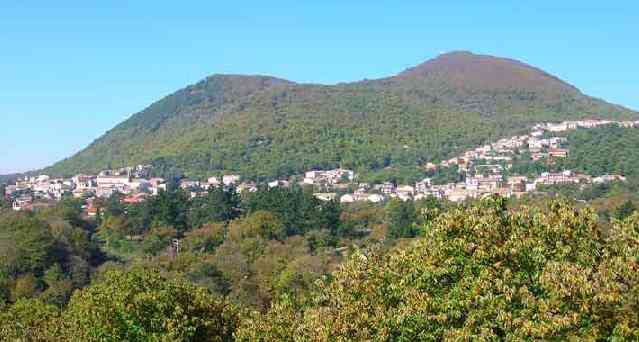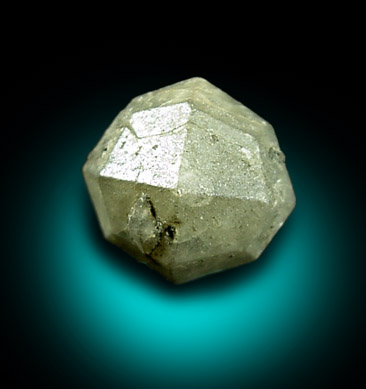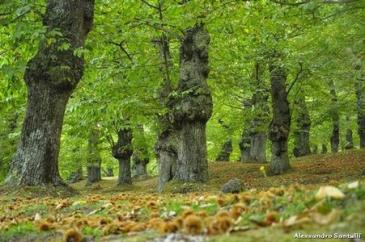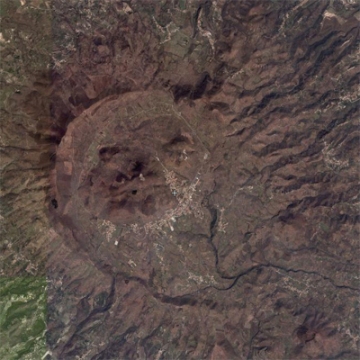Located some 60 km NNW of Naples in the Campanian province of Caserta lies the medieval town of Roccamonfina, cradling the slopes of an old stratovolcano, considered extinct since its last eruption was at least 50,000 years ago. Roccamonfina is famous for its cuisine based on chestnuts and funghi porcini; Penny Buns or Boletus Edulis.
The volcano itself is massive. With a basal area 17.6 km in diameter, twice the size that of Vesuvius/Monte Somma, the main cone was originally more than 1800 m high before it was destroyed about half a million years ago. Today the mountain is truncated by a caldera measuring some 5 by 6 km in which the current summit cones has grown to an altitude of 1005 m. The last eruptive period is thought to have ended 50,000 years ago, and the volcano is thought to be extinct, a view that may be supported by exploration of its geothermal potential which found a very low temperature of 35°C at 886 m. Apart from this, it would seem that everything else is highly disputed and not very much known except that it is considered to be “a typical alkali-potassic volcano” (Capuano, Continisio & Gasparini; 1992)

Fig 2. The twin thrachyandesitic domes that form the current peak of the Roccamonfino Volcano with the town of Roccamonfina at their base. (itineraiparlli.org)
To give a brief summary, the age of the Roccamonfina volcano is variously given as between 1.5 million years (Watts, 1987) and 590 thousand years (Gianetti, 2001). The causes of the caldera collapse given by Watts is that there was a series of St Helens-type eruptions and flank collapses that led to its formation. Gianetti directly disputes this as caldera collapses due to sector sliding “are improbable as tested by the absence of rock-slide avalanche deposits” and considers the most likely cause to be incremental collapses “through repetitive draining of the magma chamber(s) resulting from a succession of moderate-sized volcanic events”. De Rita and Giordano (1996) puts the volcano’s age as 630 – 50 kA and dismiss both the above theories on stratigraphical evidence. Instead they propose that “Geomorphological and structural observations, together with geophysical evidence, suggest that collapse of the volcano summit occurred as a mechanical re-adjustment to the high rate of the Garigliano graben extension during a climax of the regional tectonism at around 400 ka bp”. Going back to Tedesco (“Main Lines of the History of the Roccamonfina Volcano”, 1965) attributes the caldera collapse to “eruptions of a vast magmatic portion of dubitative thrachyte composition produce a thick sequence of mudflows and <<pyroclastic flows>>”.
Great! We have a volcano at least four times the size of Vesuvius with a 5 x 6 km caldera (Tedesco gives 5 x 7 km) and four different scientific papers proposing four different causes for its formation of which two are irreconcilable with each other and the other two. At least Gianetti and Tedesco agree that the caldera collapse could be due to a large eruption or a series of large eruptions.
So what do we know about the Roccamonfina volcano? Here I am trying to reconcile all these various and conflicting statements to piece together a credible, but by no means definitive or accurate account:
Some 1.5 million years ago, volcanic activity began in the Roccamonfina area. 600,000 years ago, this activity had built a 1800 m high stratovolcano composed mainly of leucitic lavas and tuffs with several monogenetic cones on its flanks, some of which were composed of thrachytic lavas.

Leucite from Roccamonfina. Image copyright by John Betts (http://webmineral.com/)
Then followed two main periods of large eruptions that formed four nested calderas; the first between 546 and 474 kA and the second between 403 and 374 kA. The main cone collapsed to form the central caldera around 496 +/- 50 kA. The collapse of the main cone was accompanied by a ring fracture concentric with and outside the main caldera. This would, to my mind at least, indicate that the main caldera was formed by a large eruption, at least VEI 6+, that was not accompanied by the emission of ignimbrites and that, for reasons at present unknown, the evidence for this has not been found and could be “lost”.

Fig 5. Roccamonfina chestnut forest, a most relaxing environment for someone writing their doctoral thesis on the Roccamonfina Volcano. (Alessandro Santulli)
After the collapse of the main caldera, a lake formed in the NW part which has left lacustine deposits inside the caldera. Following this, two large thrachyandesitic domes were extruded around, probably during a second period of activity 385 – 285 kA. This was accompanied by a trachytic ashflow that filled the caldera, the radial valleys and spread out into the surrounding plains. Again, evidence of a very large eruption that seems to have gone missing from the records.
As to the final period of activity that ended about 50,000 years ago, I have been unable to trace any evidence for it except the statement. It would seem that the Roccamonfina Volcano is understudied which perhaps is not surprising considering its extinct status. That said, is there a young geology student out there looking for a study object for her or his doctoral thesis? The setting of Roccamonfina and its cuisine would make this task a most agreeable one!
One last tidbit. In a study published in 2004 of the underlying crust using shear wave velocities obtained from seismic events recorded in 1988–2004 at Roccamonfina station of the INGV-RSNC network, Nunziata & Gerecitano have built the following model: The Roccamonfina edifice stands upon a 5 km thick sedimentary zone (i.e. one rich in silicic rocks, minerals and water). Below this they have found a high velocity zone that corresponds to a body of solidified magma. The corresponding layer of sedimentary rock underlying the surrounding Appenines is 10 km thick. Below the layer of solidified magma, Nunziata & Gerecitano found evidence for a low velocity layer with an average thickness of 10 km which can be associated with the presence of partial melting and they interpret as magmatic reservoir. Such low velocity layer was also found below the surrounding Apennines but with a reduced thickness of 2–3 km. This layer extends to the Campanian Plain and to the Neapolitan volcanic area, from Campi Flegrei to Somma-Vesuvius.
It would thus seem that the Roccamonfina volcano has depleted some 5 km of the sedimentary layer during its lifetime and the only logical conclusion would seem to be that the process responsible is absorption and remobilisation as magma which then has erupted. If you want to, you could imagine it as some kind of a magmatic blowtorch burning its way through the sedimentary layer. Furthermore, it would seem that the zone of partial melting is also much thicker than elsewhere but that no new energy has been added to this for a very long time. In a private conversation with Carl, he speculated that it could have something to do with isostatic rebound after the glaciation of the Alps and Appenines and that as long as they were glaciated and thus depressed, there existed a fold that allowed magma access to the Roccamonfina area. As there is evidence of a physical link between them, the zone of partial melting, and that the first eruptions of Campi Flegrei are thought to have occurred some 40 kA before present but after the last eruptions at Roccamonfina, it is entirely possible that isostatic rebound has shifted the volcanism from Roccamonfina to the Naples area.
HENRIK
UPDATE: Large 7.7M Earthquake in Pakistan
A large earthquake has happened in the Haji Haram Khan mountains. Due to the lack of local building codes a large number of casualties is expected to have occured. Discussions about this is welcome in the comment thread below.
http://www.emsc-csem.org/Earthquake/earthquake.php?id=335667
CARL
Update: Image of the crater of Vesuvius from http://www.mondodelgusto.it/2009/03/05/arte-natura-nel-parco-regionale-roccamonfina/ replaced with image of Leucite on Henrik´s request. chryphia





about volcanoes: their are some volcanoes that are constantly having minor eruptions and having fresh magma arriving from depth (Etna, Sakurajima … ). Their conduits are practically open all the time and form a sort of high way for magma. Now I’m wondering if it would be noticed with such volcanoes when a bigger blob of magma rises than usual. Most signals of magma rising we look for, are actually signals of things that hamper the magma on its way. But what if with every small eruption the conduits become a little bigger, so that a very big blob of magma can rise very fast to the surface. Would we notice in such case that the eruption will be bigger than usual in advance?
Good question. In other words, if a really big eruption were to take place at Sakurajima, how early in advance scientists would know before they raise the alarm?
I have the same overall impression that this particular volcano is showing signs of unrest never seen since I have been able to observe it in a daily basis.
If it was powerfull enough to create earthquakes as the unusualy large blob fractured rock on the way up they could spot it days in advance. If it does not cause earthquakes then a day down to hours. Or perhaps even minutes in some cases. Even sometimes not at all…
The increasing pressure out in the resurgent dome in the center of the caldera uplift have been known for years. So, that the mother-chamber had an increase in pressure has been known, and as such has gived a sign that the risk is increasing. If they could track when the magma blob started to push from mother-chamber to Sakurajimas chamber is not known to me.
I guess they knew. This is a very heavily monitored volcano.
In the case of Sakurajima, isn’t there a danger for developing a boiling-frog-syndrome (certainly with the locals)? You just watch the volcano having harmless eruptions that every time become a little bit bigger. Because you’re so used to having the volcano erupting harmless, you don’t notice that the volcano is becoming dangerous until it’s too late. (maybe scientist will see some signs,but the locals has to believe them that it is worth to evacuate)
The 1914 eruption was a VEI4 and joined the island to the mainland. The eruption was preceded by earthquakes, which alerted the local residents to evacuate. The locals have regular evacuation drills so provided Sakura-jima gives warning via earthquakes, etc, there will be an evacuation again.
The 1914 eruption produced effusive lava flows in addition to the more “usual” eruption columns and PDCs.
http://en.wikipedia.org/wiki/Sakurajima
I think there might be a risk of Boiling Frog Syndrome this time. For decades it has bopped on a few hundred times a year. Now it still bops that frequently, but slowly the bops grow bigger, so it is likely that they will get used to the bops being a tad bigger. This is a risk, but I think the authorities are doing their work.
Would a bigger blob have a larger HT?
Probably, but how much larger HT (than normal small eruptions) and how much in advance will you notice it if their are no obstacles for the magma?
The 1914 eruption was heralded by EQ activity and the effusive lava flows by a large EQ which caused fatalities.
It would have more powerfull Long Period events. Also, the frequency would shift upwards as the pressure increases. Any cracking of rock would also be Broad in Frequency.
Hello Sa’Ke!
Good questions! To answer that we would have to recognize that they are different types of volcanoes. Boris said a while ago that Etna reacts to blobs of magma arriving. If much magma arrives it erupts often and more spectacular.
Sakurajima has had more influx of lava than one would think. There have been constant uplift out in the caldera center even though Sakurajima has been erupting. And nothing has happened to Sakurajima. Up until now. My guess is that the pressure in the central magma chamber finally became to high and magma spilled over into the local magma chamber of Sakurajima. So, in a sense a blob of magma arrived and the eruption rate and violence increased a lot as we can see on the images and cameras.
Yes we would notice signs, or perhaps not. On a well monitored volcano like Etna the professionals would see changes in frequency and amplitude signalling a change of the stress load in the conduit. It is not perfect and would not tell anything exactly, but it would say “this is large than average” at least. But, we as volcano followers would not see anything since we normaly do not get the data in enough detail to even see it.
Sakura-jima. Showing eruption at the Showa Crater and some small emissions from another crater (outlined in orange). The wind is in the wrong direction for the latter to be from the Showa Crater.
Source: http://webcam-svo2.pr.kyoto-u.ac.jp/local/camera.html
I don’t think that’s really evidence of a second crater opening. I’ve watched SakuraJima a lot over the last year, and it has a lot of clouds that condense when running over the summit. That – and some of the emissions from the eruption scatter from the showa crater, which makes it look like there may be more than one crater erupting.
If a new crater had opened up, the authorities monitoring Sakurajima would surely have mentioned something about it as that would be pretty big news. SakuraJima is also one of the most well-monitored volcanoes in the world (although the lack of webicorders is annoying), so it would be well noticed by people much closer.
Yesterday you correctly proved me wrong when i said it seemed to erupt from a new vent. It looked a lot more to the east (right)from this cam.http://www.opentopia.com/webcam/8683?viewmode=livevideo
or tarumizu. You where right, this was probably due a different wind direction. The bulk still comes from the showa creater but today you could see little puffs coming over the northen crater edge. Nothing serious, but clearly not from the main showa crater it self. Could be a small fumarole or something just over the edge.
Anyway i saw puffs like in karenz picture a couple of times today.
Fumaroles might be right here. The minimadake crater is right next to the Showa crater, and it wouldn’t be surprising if some gas and perhaps light ash was escaping from there during some of the eruptions at Showa.
So if anything, it would be a small reactivation of an old crater, but I don’t think a new crater is opening.
Footage of the the Pakistan earthquake island
http://www.bbc.co.uk/news/world-asia-24238033
This photo shows people on the island, which gives a sense of scale:
http://www.bbc.co.uk/news/in-pictures-24240327
I would say that the island is 12 to 15 meters high now that I have people to compare with.
Also, on this sharp picture it is easy to see:
1. That it is made out of muddy sea bottom
2. That it was a reef no deeper than 5 meters, the algae on the right hand side give that away.
And a close up of the surface of the island:
http://www.bbc.co.uk/news/in-pictures-24240327
Mud and sedimentary rock…
Interesting ruminations upon Sakurajima. Hopefully this one won’t come with any “surprises”. …
Klyuchevskoy: http://www.kscnet.ru/ivs/kvert/video_camera/Klyuchevskoy2.html
Incendio in Brazil, seems an erupting volcano: http://vejoaovivo.com.br/sc/sao-francisco-do-sul/estrada-do-ferry-boat.html
Warehouse fertilizer catches fire and toxic smoke reaches quarters
Shame!
I wonder if Sakurajima is building to a big one.
It no doubt is, but the question is the time period and how long the “building” phase would last for. Can we expect it to go on building for another month prior to a big one? Or would it take another 20-40 years before we can expect a larger eruption?
Small swarm on TFZ: http://en.vedur.is/earthquakes-and-volcanism/earthquakes/tjornes-small/
not only in TFZ:
25.09.2013 12:03:31 64.053 -21.383 2.9 km 0.9 90.01 1.9 km NNE of Hellisheiðarvirkjun
25.09.2013 11:33:06 64.049 -21.333 12.8 km 0.2 31.81 3.4 km ENE of Hellisheiðarvirkjun
25.09.2013 10:17:59 63.910 -22.008 9.5 km 0.6 52.26 3.8 km NE of Krýsuvík
More on the “Zalzala Jazeera” mud/sand volcano (Pakistan 7.7 earthquake creates temporary “earthquake island” off coast):
Methane gas is emanating from a small island created in the Arabian Sea by the deadly earthquake that hit southwest Pakistan, prompting experts to warn people not to go near it.
However, the site has fascinated local residents, who have thronged the coastline in Balochistan province to get a glimpse of the new piece of land that emerged from the sea.
The 7.7-magnitude quake that struck Balochistan remote Awaran district yesterday killed over 260 people and affected some 300,000. The island sprang from the seabed off the coastline near the port of Gwadar, 400 km from the quake’s epicentre. The Pakistani media has dubbed it the “Zalzala Jazeera” or “quake island”.
Experts from the National Institute of Oceanography who are evaluating the island said it was spewing methane gas at several points. There is a visible presence of marine life on the island, they said.
“Our team found bubbles rising from the surface of the island that caught fire when a match was lit and we forbade our team from starting any fires. It is methane gas, Mohammad Danish, a marine biologist from the National Institute of Oceanography, told Geo News.
The island is 60 to 70 feet above sea level and its land mass measures about 120 metres by 300 metres. This was the third time in 15 years that such a phenomenon has occurred along the Balochistan coast. Earlier, islands emerged in 1999 and in 2011 at a distance of two kilometres from the Makran coast near the point where the Hingol river drains into the sea.
Both these islands emerged without an earthquake and collapsed in strong currents and winds. The same area witnessed an island’s emergence in 1945 following an earthquake.
Source: Pakistan’s ‘quake island’ spewing methane gas (Indian Express)
http://www.indianexpress.com/news/pakistans-quake-island-spewing-methane-gas/1174159/
Some photos: http://dawn.com/news/1045332/gwadars-quake-island-unlikely-to-last-experts
Recent study published in the journal Nature Geoscience about previous events, summary (Earthquakes release massive amounts of methane) c/o Nature World News, 29 July 2013:
http://www.natureworldnews.com/articles/3204/20130729/earthquakes-release-massive-amounts-methane.htm
Interesting thanks.
So if i understand it right. After some rumbling of Pakistan’s innards, it farted a pocket of methane under the seebed and blowing it up like a balloon that’s now slowely deflating?
Poetic and entirely correct! 🙂
More photos including a blurry aerial one showing the shape of the island
http://www.dailymail.co.uk/sciencetech/article-2431913/Massive-Pakistani-earthquake-pushes-brand-new-18-metre-high-island-sea.html
I’ve been trying to find any realtime seismic data for sakurajima, but i can’t find anything. I tried translating to japanese before googling. But i couldn’t find anything. The only thing i could find was a realtime seismic station all the way in the north of Kyushu, Oita Nakatsue. That’s rougly 200km north of sakurajima, pretty useless. Did anyone here had better luck than me or is there simply nothing online?
Oh, and that’s te second time i forget to mention how nice the site looks in it’s new suite. excellent work 🙂
Thank you, and sadly I do not have any link to a seismogram.
Edit: Someone should email and ask them…
I’ve searched quite a bit for webicorders, but they do not have anything active online. The official website they have for it is quite outdated by any standards, and doesn’t display much info. The best source of info is a monthly pdf the Japanese weather agency puts out on volcanoes – although you can only find out updates a month after the fact.
A deer with wings
http://www.dailymail.co.uk/news/article-2430413/Golden-eagle-attacking-DEER-unbelievable-moment-photographed-case-kind.html
New post is up!
https://volcanocafe.wordpress.com/2013/09/25/the-most-dangerous-volcano-of-the-world-talk-part-i/